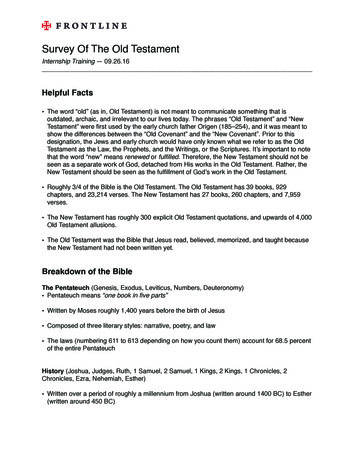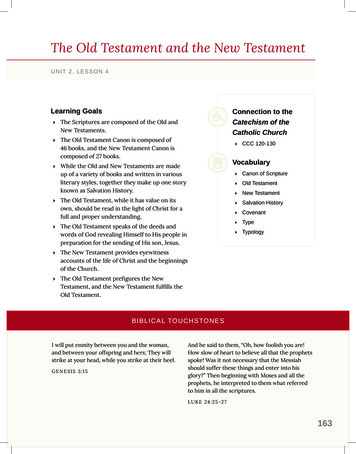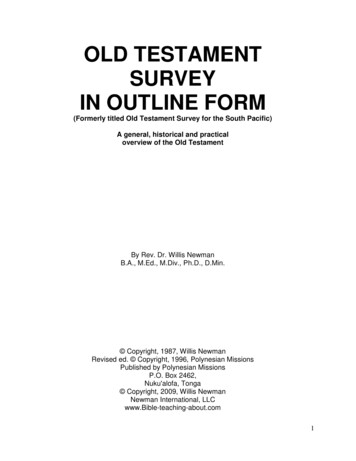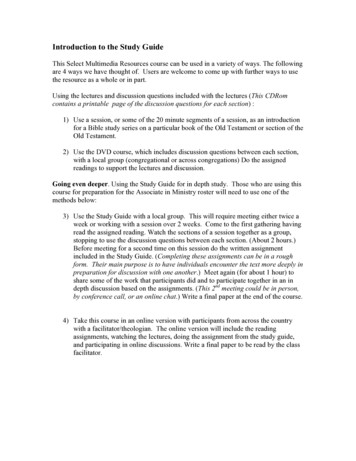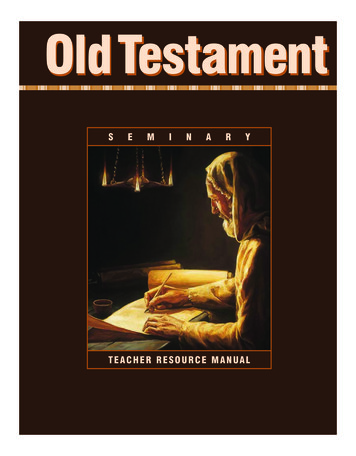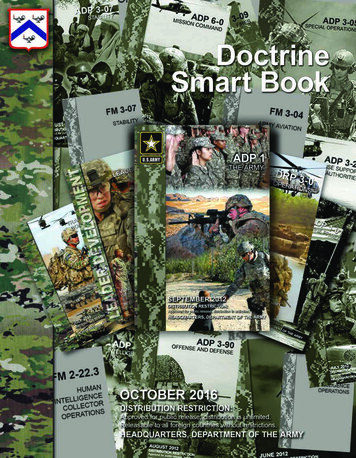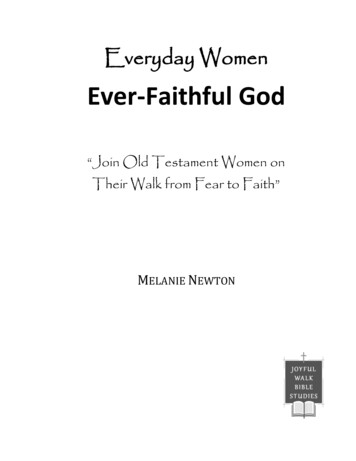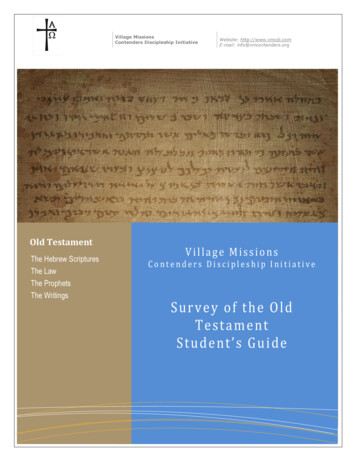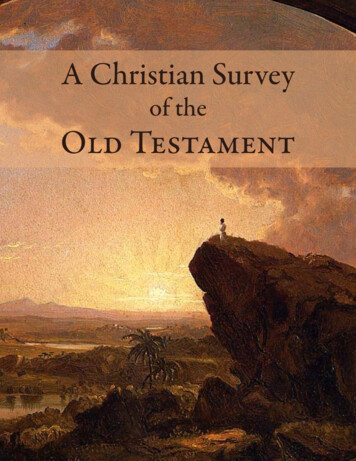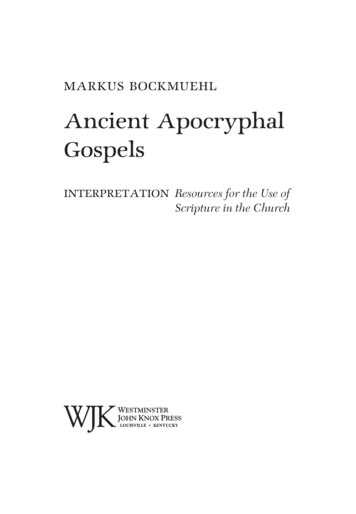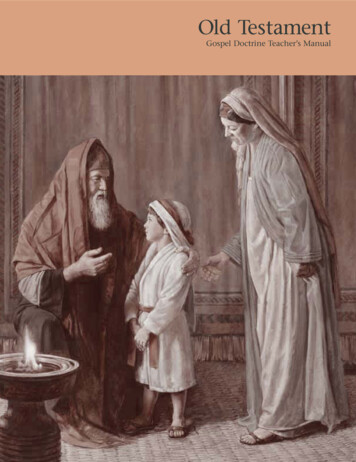
Transcription
Old TestamentGospel Doctrine Teacher’s Manual
Old TestamentGospel Doctrine Teacher’s ManualPublished byThe Church of Jesus Christ of Latter-day SaintsSalt Lake City, Utah
Comments and SuggestionsYour comments and suggestions aboutthis manual would be appreciated.Please submit them to:Curriculum Planning50 East North Temple Street, Floor 24Salt Lake City, UT 84150-3200USAE-mail: cur-development@ldschurch.orgPlease list your name, address, ward, andstake. Be sure to give the title of the manual.Then offer your comments and suggestionsabout the manual’s strengths and areas ofpotential improvement.Cover: Hannah Presenting Her Son Samuel to Eli, by Robert T. Barrett 1996, 2001 by Intellectual Reserve, Inc.All rights reservedPrinted in the United States of AmericaEnglish approval: 1/01
ContentsLesson Number and TitleHelps for the TeacherPagev1 “This Is My Work and My Glory” (Moses 1)12 “Thou Wast Chosen Before Thou Wast Born”(Abraham 3; Moses 4:1–4)53 The Creation (Moses 1:27–42; 2–3)94 “Because of My Transgression My Eyes Are Opened”(Moses 4; 5:1–15; 6:48–62)125 “If Thou Doest Well, Thou Shalt Be Accepted” (Moses 5–7)176 “Noah . . . Prepared an Ark to the Saving of His House”(Moses 8:19–30; Genesis 6–9; 11:1–9)237 The Abrahamic Covenant(Abraham 1:1–4; 2:1–11; Genesis 12:1–8; 17:1–9)278 Living Righteously in a Wicked World (Genesis 13–14; 18–19)329 “God Will Provide Himself a Lamb”(Abraham 1; Genesis 15–17; 21–22)3610 Birthright Blessings; Marriage in the Covenant (Genesis 24–29)4011 “How Can I Do This Great Wickedness?” (Genesis 34; 37–39)4612 “Fruitful in the Land of My Affliction” (Genesis 40–45)5113 Bondage, Passover, and Exodus (Exodus 1–3; 5–6; 11–14)5614 “Ye Shall Be a Peculiar Treasure unto Me” (Exodus 15–20; 32–34)6215 “Look to God and Live” (Numbers 11–14; 21:1–9)6816 “I Cannot Go Beyond the Word of the Lord” (Numbers 22–24; 31:1–16)7317 “Beware Lest Thou Forget” (Deuteronomy 6; 8; 11; 32)7718 “Be Strong and of a Good Courage” (Joshua 1–6; 23–24)8219 The Reign of the Judges (Judges 2; 4; 6–7; 13–16)8720 “All the City . . . Doth Know That Thou Art a Virtuous Woman”(Ruth; 1 Samuel 1)9221 God Will Honor Those Who Honor Him (1 Samuel 2–3; 8)9622 “The Lord Looketh on the Heart” (1 Samuel 9–11; 13; 15–17)10123 “The Lord Be Between Thee and Me For Ever” (1 Samuel 18–20; 23–24)10724 “Create in Me a Clean Heart” (2 Samuel 11–12; Psalm 51)111iii
25 “Let Every Thing That Hath Breath Praise the Lord” (Psalms)11726 King Solomon: Man of Wisdom, Man of Foolishness (1 Kings 3; 5–11)12327 The Influence of Wicked and Righteous Leaders(1 Kings 12–14; 2 Chronicles 17; 20)12828 “After the Fire a Still Small Voice” (1 Kings 17–19)13429 “He Took Up . . . the Mantle of Elijah” (2 Kings 2; 5–6)13930 “Come to the House of the Lord” (2 Chronicles 29–30; 32; 34)14431 “Happy Is the Man That Findeth Wisdom” (Proverbs and Ecclesiastes)15132 “I Know That My Redeemer Liveth” ( Job 1–2; 13; 19; 27; 42)15733 Sharing the Gospel with the World (Jonah 1–4; Micah 2; 4–7)16234 “I Will Betroth Thee unto Me in Righteousness” (Hosea 1–3; 11; 13–14) 166iv35 God Reveals His Secrets to His Prophets (Amos 3; 7–9; Joel 2–3)17036 The Glory of Zion Will Be a Defense (Isaiah 1–6)17537 “Thou Hast Done Wonderful Things” (Isaiah 22; 24–26; 28–30)17938 “Beside Me There Is No Saviour” (Isaiah 40–49)18339 “How Beautiful upon the Mountains” (Isaiah 50–53)18740 “Enlarge the Place of Thy Tent” (Isaiah 54–56; 63–65)19041 “I Have Made Thee This Day . . . an Iron Pillar”( Jeremiah 1–2; 15; 20; 26; 36–38)19442 “I Will Write It in Their Hearts” (Jeremiah 16; 23; 29; 31)19843 The Shepherds of Israel (Ezekiel 18; 34; 37)20144 “Every Thing Shall Live Whither the River Cometh” (Ezekiel 43–44; 47)20745 “If I Perish, I Perish” (Daniel 1; 3; 6; Esther 3–5; 7–8)21146 “A Kingdom, Which Shall Never Be Destroyed” (Daniel 2)21647 “Let Us Rise Up and Build” (Ezra 1–8; Nehemiah 1–2; 4; 6; 8)22048 “The Great and Dreadful Day of the Lord” (Zechariah 10 –14; Malachi)225
Helps for the TeacherPresident Gordon B. Hinckley said: “I hope that for you [studying the scriptures]will become something far more enjoyable than a duty; that, rather, it will become a love affair with the word of God. I promise you that as you read, yourminds will be enlightened and your spirits will be lifted” (“The Light withinYou,” Ensign, May 1995, 99).As a Gospel Doctrine teacher, you have the opportunity to help the membersof your class learn to love the Old Testament and find the enlightenment thatPresident Hinckley promised. As you teach, you will be following the exampleof the Savior, who loved the scriptures and used them to teach his disciples.Just after Jesus was resurrected, he used the scriptures to teach two disciplespowerful truths. A disciple named Cleopas and his companion were walkingalong the road to Emmaus, discussing the news they had just heard that Jesus’body was no longer in the sepulchre. As they walked, they were joined by Jesusbut did not recognize him. He asked what they were talking about and why theywere sad, and they told him of the Crucifixion and Resurrection. When Jesusheard this, he “expounded unto them in all the scriptures the things concerninghimself” (Luke 24:27).Cleopas and his companion asked the Savior to stay with them, and as they satto eat they recognized him as the resurrected Lord. He then vanished from theirsight, and they said to one another, “Did not our heart burn within us, while hetalked with us by the way, and while he opened to us the scriptures?” (Luke 24:32).The scriptures that prompted the disciples’ hearts to burn were from the booksof Moses and the prophets—the scriptures that we know as the Old Testament.As you teach these same sacred truths, the Holy Ghost will testify of their truthfulness to your class as he did to Cleopas and his companion.Studying the Old Testament should strengthen class members’ testimonies ofthe Savior and their commitment to live his gospel. Guided by the Spirit in theirstudy, class members should be able to testify with Job, “I know that my redeemerliveth, and that he shall stand at the latter day upon the earth” ( Job 19:25).Teaching bythe SpiritWhen preparing for Gospel Doctrine class, it is important that you seek inspiration and guidance from the Spirit of the Lord. “The Spirit shall be given unto youby the prayer of faith,” said the Lord, “and if ye receive not the Spirit ye shall notteach” (D&C 42:14). Remember that the Holy Ghost is the teacher in your class.The way you seek the Spirit is through prayer, fasting, daily study of the scriptures,and obedience to the commandments. While preparing for class, pray for the Spiritto help you understand the scriptures and the needs of class members. The Spiritcan also help you plan meaningful ways to discuss the scriptures and apply themto the present (1 Nephi 19:23). With the help of the Spirit, you will become aneffective instrument in the hands of the Lord to teach his word to his children.v
Some suggestions for how to invite the Spirit into your class are given below:1. Invite class members to offer prayers before and after the lesson. During class,pray in your heart for the Spirit to guide you, to open the hearts of classmembers, and to testify and inspire.2. Use the scriptures (see “Focusing on the Scriptures” below).3. Bear testimony whenever the Spirit prompts you, not just at the end of thelesson. Bear testimony of the Savior. Frequently invite class members to beartheir testimonies.4. Use hymns, Primary songs, and other sacred music to prepare class members’hearts to feel the Spirit.5. Express love for class members, for others, and for Heavenly Father and JesusChrist.6. Share insights, feelings, and experiences that relate to principles in the lesson.Invite class members to do the same. Members could also tell how they haveapplied or taught what was discussed in previous lessons.Focusing onthe ScripturesPreparing for Gospel Doctrine class requires diligent, prayerful study of the scriptures. The Lord commanded, “Seek not to declare my word, but first seek to obtainmy word.” As you obtain his word through scripture study, the Lord promisesthat “your tongue [shall] be loosed; then, if you desire, you shall have my Spiritand my word, yea the power of God unto the convincing of men” (D&C 11:21).This manual is a tool to help you teach the scriptures. Encourage class membersto bring their scriptures to class every week. Where possible, Latter-day Sainteditions of the scriptures should be used. Refer to the excerpts from the JosephSmith Translation of the Bible that are in the Bible footnotes and in the sectionfollowing the Bible Dictionary.During class, keep discussions focused on the scriptures. Be judicious in your useof commentaries and other nonscriptural sources of information. Class membersshould be taught to seek knowledge and inspiration from the scriptures and thewords of the latter-day prophets.Each class member should be given a copy of the Old Testament Class MemberStudy Guide (34592). This booklet provides summaries and questions that willhelp class members understand the scriptures, ponder how to apply them, andprepare for class discussion. Encourage parents to use the study guide in familyscripture study.Lesson FormatThis manual has been written for youth and adult Gospel Doctrine classes andis to be used every four years. The lessons have been designed to contain moreinformation than you will probably be able to teach in one class period. Seek theSpirit of the Lord in selecting the scripture accounts, questions, and activities thatbest meet the needs of class members.Each lesson includes the following sections:1. Purpose. The purpose statement provides you with a main idea to focus on asyou prepare and teach the lesson.vi
Helps for the Teacher2. Preparation. The first part of this section summarizes the scripture accountsin the lesson outline. Some lessons suggest additional reading that will giveyou increased understanding. In many lessons this section also includes othersuggested preparations, such as materials you may want to bring to class.3. Attention activity. This section consists of a simple activity, object lesson, orquestion to help class members prepare to learn, participate, and feel theinfluence of the Spirit. Whether you use the manual’s attention activity orone of your own, it is important to focus class members’ attention at thebeginning of the lesson. The activity should be brief.4. Scripture discussion and application. This is the main part of the lesson. Prayerfully study the scripture accounts so you can teach and discuss them effectively.Use the suggestions in “Helps for Teaching the Scriptures” (below) to vary theway you teach and to maintain class members’ interest.5. Conclusion. This section helps you summarize the lesson and encourage classmembers to live the principles you have discussed. It also reminds you to beartestimony. Be sure to leave enough time to conclude each lesson.6. Additional teaching ideas. This section includes additional truths from the scripture accounts, alternate teaching approaches, activities, and other suggestionsthat supplement the lesson outline. You may want to use some of these ideasas part of the lesson.Helps for Teachingthe ScripturesUse the following suggestions to teach scripture accounts more effectively andwith greater variety:1. Help class members understand what the scriptures teach about Jesus Christ,the Jehovah of the Old Testament, whose birth, mortal mission, second coming, and millennial reign are prophesied in the Old Testament.2. Ask class members to think of and share specific ways that a scripture passagecan apply in their lives.3. In addition to the doctrine, give emphasis to the stories in the Old Testament,particularly the stories of faith, ensuring that class members understand themand discuss ways to apply them.4. Have class members look for words, phrases, or ideas that are repeated oftenin a scripture passage or that have special meaning for them.5. Write on the chalkboard some phrases, key words, or questions that relate to thescripture account. Then read or summarize the account. As class members hearthe phrases, key words, or answers to the questions, stop and discuss them.6. Throughout the Book of Mormon, the phrase “and thus we see” is used tointroduce a summary of the principles taught. After discussing a scripturepassage, ask class members to complete the sentence “and thus we see” inorder to explain the gospel principle being taught.7. Look for and discuss symbols that are used throughout the Old Testament.For example, the bride and the Bridegroom represent Israel and the Savior.8. Notice how people or events in the scriptures can be contrasted with eachother. For example, you could contrast Cain with Abel and Enoch (Mosesvii
5–7); David and Bathsheba (2 Samuel 11) with Joseph of Egypt and Potiphar’swife (Genesis 39:7–13); or the prophet Elijah with wicked King Ahab (1 Kings16:29–33; 17–19).9. Conduct a readers’ theater by having class members read the words of thedifferent people in the scriptures.10. Divide the class into two or more small groups. After reviewing the scriptureaccount, have each group write down the principles taught in the account.Then have the groups take turns discussing how these principles apply intheir lives.11. Invite class members to bring a pencil to mark significant verses as youdiscuss them.EncouragingClass DiscussionYou normally should not give lectures but should try to help class members participate meaningfully in discussing the scriptures. As class members participate,they more effectively learn about the scriptures and better understand how toapply gospel principles. Seek the Spirit’s guidance in deciding which questions toask, how to organize them, and how to develop them. Class discussions shouldcenter on matters that help members come unto Christ and live as his disciples.Redirect discussions that do not accomplish these purposes.Scripture references are provided to help you and class members find answers tomost questions in the scriptures. Answers to some questions will come from classmembers’ experiences.Covering all the lesson material is less important than helping class membersbetter understand the scriptures and commit themselves to increased discipleship. If class members are learning from a good discussion, it is often helpful tolet it continue rather than try to cover all the lesson material.Use the following guidelines to encourage class discussion:1. Ask a question and then give a scripture reference so class members can findthe answer.2. Ask questions that require thought and discussion, rather than yes or noanswers. Questions that begin with why, how, who, what, when, and where areusually most effective for encouraging discussion.3. Encourage class members to share their feelings about what they are learningfrom the scriptures. Also encourage them to share experiences that show howscriptural principles can be applied to life. Make positive comments about theircontributions.4. Be sensitive to the needs of each class member. Although all class membersshould be encouraged to participate in class discussions, some may hesitate torespond. You may wish to speak privately with them to find out how they feelabout reading aloud or participating in class. Be careful not to call on classmembers who might be embarrassed.5. Encourage class members to prepare for class by studying the assigned scriptureaccount and the Old Testament Class Member Study Guide (34592). They will bebetter able to participate in discussions if they are prepared. Suggest that classmembers discuss the scripture accounts and the lessons with their families.viii
“This Is My Workand My Glory”Lesson1Moses 1PurposeTo help class members understand that (1) we are children of God, (2) we canresist Satan’s temptations, and (3) God’s work and glory is to bring to pass ourimmortality and eternal life.Preparation1. Prayerfully study the following scriptures from the Pearl of Great Price:a. Moses 1:1–11. Moses sees God and talks with him face to face. Moses learnsthat he is a son of God in the similitude of the Only Begotten of the Father.Note: Class members should understand that Jehovah, not Heavenly Father,appeared to Moses in this vision. Jehovah was the premortal Jesus Christand the God of the Old Testament. He is one with his Father in purpose andrepresents him in power and authority. His words are those of the Father,and sometimes, as in Moses 1:6, he speaks in the first person for the Father.(See James E. Talmage, The Articles of Faith, 12th ed. [1924], 470–71.)b. Moses 1:12–23. Satan confronts Moses; Moses casts him out.c. Moses 1:24–39. God appears again and teaches of his work and glory.2. Study the lesson and decide how to teach the scripture accounts. Because itwould be difficult to ask every question or cover every point in the lesson,prayerfully select those that will best meet class members’ needs. You mayneed to adapt some questions to fit class members’ circumstances.3. Obtain a copy of the Old Testament Class Member Study Guide (34592) for eachperson in your class. (The ward should have ordered these study guides as partof the annual curriculum order; a member of the bishopric should give themto the Sunday School presidency.)4. If you use the second attention activity, obtain a paper or cloth bag and placein it a few everyday items, such as a rock, comb, and pencil.Suggested LessonDevelopmentIntroduction to theOld TestamentThe Old Testament is an account of God’s dealings with his covenant peoplefrom the time of the Creation to a few hundred years before the Savior’s birth.The Old Testament provides powerful examples of faith and obedience. It alsoshows the consequences of forgetting, disobeying, or opposing God. Itsprophecies bear witness of the Messiah’s birth, redeeming sacrifice, secondcoming, and millennial reign.In addition to the Old Testament, this course includes the books of Moses andAbraham from the Pearl of Great Price. These books provide important additionsand clarifications to some of the material in the book of Genesis. The book ofMoses is an extract from the Joseph Smith Translation of the Bible. The book ofAbraham is a translation that the Prophet Joseph Smith made from some Egyptianpapyri. For additional information about the Joseph Smith Translation, see1
“Joseph Smith Translation,” Bible Dictionary, page 717. Note also that selectionsfrom the Joseph Smith Translation are included after the Bible Dictionary in theLatter-day Saint edition of the King James Bible.Attention ActivityYou may want to use one of the following activities (or one of your own) to beginthe lesson. Select the activity that would be most appropriate for the class.1. Ask class members to look in Moses 1:6, 20–22, and 39 to identify importanttruths that are revealed. Answers may vary. Explain that this lesson will focuson the three truths that are listed under “Purpose” on page 1.2. Select two class members and hand them a bag that contains a few everydayitems (see “Preparation,” page 1). Tell the participants that they are going toplay a game, but do not give instructions or explain the object of the game.Ask the participants to open the bag and begin playing. They will expect thecontents of the bag to explain the game. However, the contents do not providethis information, and the participants will wonder what they are supposed todo.Point out that to understand a game we must understand its object or purpose.Similarly, to understand our lives on earth we must understand the object orpurpose of our lives. Moses 1 helps us understand this by answering threeimportant questions:Who are we?How can we overcome the influence of the adversary?What is God’s work and glory?Scripture Discussion As you teach the following scripture passages, discuss how they apply to dailyand Applicationlife. Encourage class members to share experiences that relate to the scripturalprinciples. At an appropriate time during the lesson, hand out the Old TestamentClass Member Study Guide (34592) and encourage class members to use it tofurther their personal and family scripture study.1. God teaches that Moses is a son of God.Teach and discuss Moses 1:1–11. What did Moses learn about God from the experiences described in Moses1:1–7? What did Moses learn about himself? (You may want to have classmembers note the number of times God refers to Moses as “my son” in theseverses.) What does it mean that Moses was created “in the similitude” of the Savior?(Moses 1:6). What difference can it make in our lives to know that we arechildren of God, created in the similitude of his Son?Elder Dallin H. Oaks taught: “Consider the power of the idea taught in ourbeloved song ‘I Am a Child of God.’ . . . Here is the answer to one of life’s greatquestions, ‘Who am I?’ I am a child of God with a spirit lineage to heavenlyparents. That parentage defines our eternal potential. That powerful idea is apotent antidepressant. It can strengthen each of us to make righteous choicesand to seek the best that is within us. Establish in the mind of a . . . person thepowerful idea that he or she is a child of God, and you have given self-respectand motivation to move against the problems of life” (in Conference Report,Oct. 1995, 31; or Ensign, Nov. 1995, 25).2
Lesson 1 By repeatedly calling Moses “my son” and by saying that he was created “inthe similitude of mine Only Begotten,” God gave Moses confidence and anunderstanding of his worth. How can following this principle help us as parents? How can it strengthen marriages? How can it strengthen friendships?Suggest that in a world where criticism and negative, demeaning commentsseem to dominate, we should follow the Lord’s example and say things thathelp others see themselves as children of God who have dignity and worth. Moses’ importance and eternal potential are emphasized in Moses 1:1–7.However, after the presence of God withdrew from him, Moses said, “Now,for this cause I know that man is nothing” (Moses 1:10). In what sense areboth concepts true? (God is infinitely wiser and more powerful than mortalmen and women. We are nothing without him. However, as his children wehave the potential to become like him.)2. Satan confronts Moses; Moses casts him out.Teach and discuss Moses 1:12–23. When Satan came, what did he command Moses to do? (See Moses 1:12.)Why do you think Satan called Moses “son of man”? (Satan wanted Mosesto believe that he was not a son of God.) Why does Satan want us to doubtor disregard that we are children of God? How does he try to do this? How did Moses respond when Satan called him “son of man”? (See Moses1:13.) How can a strong testimony that we are sons and daughters of God helpus resist temptation? How many times did Moses tell Satan to depart? (See Moses 1:16, 18, 20, and21.) What does this teach us about resisting Satan’s efforts? How did Moses receive strength to resist the temptations of Satan? (See Moses1:18, 20–21.) How did Moses get Satan to leave? How can prayer strengthen usto resist temptation? What else can we do to gain this strength?3. God appears again and teaches of his work and glory.Teach and discuss Moses 1:24–39. After Satan departed, Moses again beheld the glory of God and was shownanother vision of the earth and its inhabitants (Moses 1:24–28). What twoquestions did Moses ask when he was shown this vision? (See Moses 1:30.)What answers did God give? (See Moses 1:31–32, 39.) Even though God has created worlds and people that are numberless to us,he assured Moses that he knows them all (Moses 1:35). How have you cometo feel that Heavenly Father and Jesus Christ know you individually and loveyou? (You may want to bear testimony of a time when you felt their love andconcern for you.) God’s work and glory is “to bring to pass the immortality and eternal lifeof man” (Moses 1:39). What is immortality? Who will receive immortality?What is eternal life? Who will receive eternal life?Elder James E. Faust said: “There is a distinction between immortality, oreternal existence, and eternal life, which is to have a place in the presence of3
God. Through the grace of Jesus Christ, immortality comes to all . . . , just orunjust, righteous or wicked. However, eternal life is ‘the greatest of all the giftsof God’ (D&C 14:7). We obtain this great gift, according to the Lord, ‘if youkeep my commandments and endure to the end.’ If we so endure, the promiseis, ‘you shall have eternal life’ (D&C 14:7)” (in Conference Report, Oct. 1988,14; or Ensign, Nov. 1988, 12). Why is it important for us to know what God’s work and glory is? What aresome specific ways we can assist him in this great work?President Gordon B. Hinckley said: “We are here to assist our Father in Hiswork and His glory, ‘to bring to pass the immortality and eternal life of man’(Moses 1:39). Your obligation is as serious in your sphere of responsibility asis my obligation in my sphere. No calling in this church is small or of littleconsequence. All of us in the pursuit of our duty touch the lives of others. Toeach of us in our respective responsibilities the Lord has said: . . . ‘In doingthese things thou wilt do the greatest good unto thy fellow beings, and wiltpromote the glory of him who is your Lord’ (D&C 81:4)” (in ConferenceReport, Apr. 1995, 94; or Ensign, May 1995, 71; see also D&C 81:5–6).ConclusionAdditionalTeaching IdeasMoses 1 teaches the powerful doctrine that we are sons and daughters of God.Invite class members to ponder the significance of this truth. Testify that ourHeavenly Father knows and loves each of us. Encourage class members to expressto their families their feelings about what they have learned from Moses 1.The following material supplements the suggested lesson outline. You may wantto use one or more of these ideas as part of the lesson.1. “Moses was left unto himself” (Moses 1:9) There may be times when we are “left unto [ourselves]” as Moses was—timeswhen we do not feel the Spirit strongly or have many trials. What can we learnfrom Moses 1 to help us deal with these times? (Answers could include: Suchdifficulties may not be due to any wrongdoing on our part; God does not leaveus entirely, as shown in verse 15; and we often gain great strength by facingour trials, calling on God, and increasing our faith.)2. All are children of God Moses received the vision that is recorded in Moses 1 before leading the children of Israel out of Egypt. How do you think this vision helped him in thiseffort, especially when he was discouraged by the people’s frequent rebellionand lack of faith? How can knowing that all of us are children of God help ateacher or leader? How can this knowledge help us in relationships with familymembers, friends, and others?3. The Joseph Smith Translation of the BibleIf Old Testament Video Presentations (53224) is available, you may want to show“The Power of the Joseph Smith Translation,” a five-minute segment, as part ofthe lesson. Remind class members that the book of Moses is an extract from theJoseph Smith Translation of the Bible.4
“Thou Wast ChosenBefore Thou Wast Born”Lesson2Abraham 3; Moses 4:1–4PurposeTo help class members understand the doctrine of foreordination and their ownresponsibility to help build up the kingdom of God and bring souls to Christ.Preparation1. Prayerfully study the following scriptures from the Pearl of Great Price and theDoctrine and Covenants:a. Abraham 3:11–12, 22–23; Doctrine and Covenants 138:53–57. Abrahamtalks with the Lord face to face and learns that in the premortal life many“noble and great” spirits were foreordained to their mortal missions(Abraham 3:11–12, 22–23). President Joseph F. Smith learns more aboutthe “noble and great ones” in a vision of the Savior’s visit to the spiritworld before His Resurrection (D&C 138:53–57).b. Abraham 3:24–28; Moses 4:1–4. Abraham and Moses are shown in visionthat Jesus Christ was chosen in the Council in Heaven to be our Savior andthat we chose to follow him. They are also shown that Lucifer (Satan) andthe spirits who followed him were cast out of heaven.2. Additional reading: Isaiah 14:12–15; Revelation 12:7–9; Alma 13:3–5; Doctrine and Covenants 29:36–39; and the rest of Abraham 3 and Doctrine andCovenants 138.Suggested LessonDevelopmentAttention ActivityYou may want to use one of the following activities (or one of your own) to beginthe lesson. Select the activity that would be most appropriate for the class.1. Point out that the scriptures become more meaningful to us when we applytheir teachings in our lives. To do this, often we must put ourselves in theplace of ancient prophets and their followers. However, in Abraham 3:22–28we do not have to put ourselves in someone else’s place because these versesare about important events in which we participated. These events took placeduring our premortal life.2. Draw 14 blank spaces on the chalkboard to represent the 14 letters in the wordforeordination. Explain that the word represented by these spaces relates to thepremortal life.Give class members 14 chances to guess which letters form the word. Whenthey guess a correct letter, write it in the appropriate space or spaces. Whenthey guess a letter not used in the word, write it elsewhere on the chalkboardto prevent duplicate guesses.When class members have filled in all the blank spaces or guessed the word,help them define its meaning. (Foreordination is God’s premortal ordination5
of his spirit children to fulfill certain missions during their mortal lives.)Explain that this lesson is about the premortal life, when many spirits wereforeordained to do important things for Heavenly Father.Scripture Discussion As you teach the following scripture passages, discuss how they apply to dailyand Applicationlife. Encourage class members to share experiences that relate to the scripturalprinciples.1. Abraham le
Each class member should be given a copy of the Old Testament Class Member Study Guide (34592). This booklet provides summaries and questions that will help class members understand the scriptures, ponder how to apply them, and prepare for class discussion. Encourage parents to use the study g
